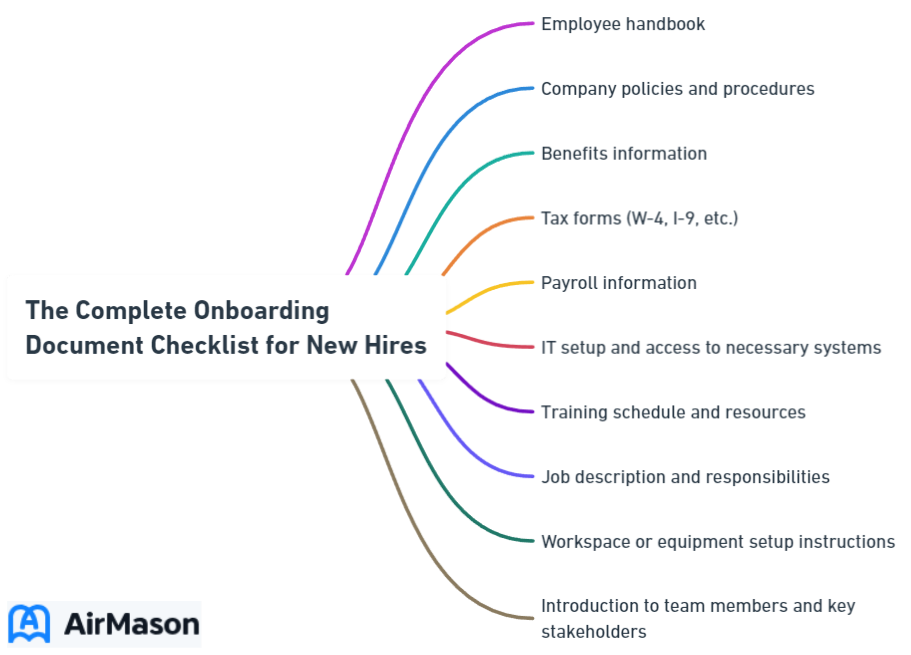
The onboarding process lays the foundation for a successful and long-lasting relationship between new hires and the organization. A well-structured onboarding process not only ensures compliance with legal and regulatory requirements but also provides employees with the necessary tools and information to excel in their roles. In this comprehensive guide, we will explore the essential onboarding documents, including the “onboarding document,” to streamline the process and enhance employee satisfaction and retention.
Key Takeaways
- Ensure compliance with essential legal and tax forms, such as Form W-4, Form I-9 and State Withholding Certificate.
- Provide new hires with an understanding of the organization’s culture, policies & structure via company specific onboarding documents.
- Streamline onboarding process using HR software to reduce paperwork & improve employee experience.
Essential Legal and Tax Forms for Onboarding
Every organization must comply with federal and state regulations when bringing new employees onboard. Avoiding penalties and maintaining a smooth onboarding process necessitates the completion and correct storage of all mandatory legal and tax forms.
The most important onboarding documents include Form W-4, Form I-9, and State Withholding Certificate.

Form W-4
Form W-4 is a tax form that determines the amount of federal income tax to be withheld from an employee’s pay. New hires must provide information about their filing status, such as marital status, any additional employment, and the number of dependents on the form.
Employers are responsible for retaining the completed W-4 forms for a period of four years to ensure compliance with applicable laws and guarantee accurate payment to employees. Employers can retrieve Form W-4 from the Internal Revenue Service’s website, reinforcing its status as a key onboarding document for new employees.
Form I-9
Form I-9 is a crucial document that verifies an individual’s eligibility for employment and their legal authorization to work in the United States. The process for completing Form I-9 includes the following steps:
- The employee must complete the form by their first day of work.
- The employer must physically examine the identification documents provided by the employee.
- The employer must finalize the form within three days of the employee’s start date.
Failing to adhere to these guidelines may result in serious penalties.
A smooth onboarding process for new hires, including each new employee, hinges on compliance with new hire paperwork, such as Form I-9 requirements.
State Withholding Certificate
A State Withholding Certificate is a crucial document for employees working in states that impose income tax. It determines the amount to be withheld from an employee’s paycheck for state taxes. Specific state requirements for State Withholding Certificates vary, with each state having its version of the state W-4 form or withholding certificate for employers to use.
Compliance and a seamless onboarding experience are guaranteed by the proper management and storage of state-specific withholding forms for each employee.
Employee Onboarding: Setting the Foundation for Success
Employee onboarding is a crucial process in any organization, encompassing the structured integration of new hires into the company’s culture, workflows, and expectations. This comprehensive approach ensures that employees are equipped with the necessary knowledge, tools, and resources to thrive in their roles from day one. Effective employee onboarding not only facilitates a smoother transition for new team members but also contributes to higher retention rates and increased productivity. By providing a structured introduction to company values, policies, and procedures, organizations set a solid foundation for employee success. Furthermore, a well-executed onboarding program fosters a sense of belonging and instills confidence in employees, allowing them to contribute meaningfully to the company’s mission and objectives. As a result, investing in a robust employee onboarding process pays dividends in the form of engaged, motivated, and loyal team members.
Company-Specific Onboarding Documents

In addition to legal and tax forms, company-specific employee onboarding documents play a vital role in helping new hires assimilate into the organization’s culture, policies, and structure. These documents for new hires provide a comprehensive overview of the company’s values, expectations, and internal hierarchy, allowing new employees to hit the ground running in their new roles.
The Employee Handbook, Organizational Chart, and Brand Guidelines are among the vital company-specific documents.
Employee Handbook
The Employee Handbook is a critical resource for new hires, providing essential information on company policies, procedures, values, and mission statement. It outlines company policies, dress code, and other pertinent details to help employees understand what is expected of them in the workplace.
Employees should sign an acknowledgment form to confirm their agreement to abide by all regulations outlined in the Employee Handbook, thereby ensuring compliance with company policies.
Organizational Chart
An Organizational Chart is a visual representation of the company’s structure, reporting hierarchy, and key contacts. It helps new hires quickly understand their colleagues’ roles and responsibilities, facilitating collaboration and achievement of shared objectives. Additionally, a well-maintained Organizational Chart can provide guidance on whom to contact with inquiries or issues and who is authorized to make specific decisions.
An accurate representation of the company’s hierarchy and reporting paths is assured by regularly updating the Organizational Chart.
Brand Guidelines
Maintaining a consistent company identity across all employees is achieved through Brand Guidelines. A comprehensive brand guideline document outlines the company’s expectations for:
- Voice
- Colors
- Logos
- Fonts
By adhering to the company’s Brand Guidelines, employees contribute to the organization’s overall image and reputation, further enhancing the company’s presence in the market.
Role-Specific Onboarding Documents

Role-specific onboarding documents cater to the unique responsibilities and expectations of each new hire’s position. These documents provide a clear understanding of the employee’s role, setting the stage for a smooth transition and successful performance in the company. Key role-specific documents include the Employment Offer Letter, Employment Contract, and Job Expectations and Goals.
Employment Offer Letter
The Employment Offer Letter is an official document outlining the details of an employment offer, including compensation, benefits, and start date. This letter serves as the foundation for the working relationship between the employer and the new hire, as it formally establishes the terms and conditions of employment.
Employees must sign the Employment Offer Letter to accept the offer, thus indicating their agreement to the stipulations within the document.
Employment Contract
An Employment Contract is a written agreement that defines the rights and duties of both parties, the employer and the employee. It is recommended to include the Employment Contract in the job offer, as it provides a clear understanding of the employee’s role and responsibilities, as well as the terms and conditions of employment.
Both the employer and the employee are protected by a well-drafted Employment Contract, which ensures a mutually beneficial and legally binding agreement.
Job Expectations and Goals
The Job Expectations and Goals document is an essential resource that provides new hires with performance metrics, professional development plans, and goal-setting worksheets. This document sets clear expectations for the employee’s role and responsibilities, facilitating a smooth transition into the company and setting the stage for successful performance.
Employees gain a better understanding of their contributions to the organization and can work towards achieving their professional objectives when specific goals and expectations are outlined.
What is Onboarding?
Onboarding is a critical process that introduces new employees to their role within an organization. It encompasses a series of activities and orientations designed to familiarize individuals with their job responsibilities, company culture, and the broader organizational structure. This phase typically begins after a candidate has accepted an offer of employment and continues through their initial days or weeks on the job. “What is onboarding” essentially revolves around integrating a new hire seamlessly into the company’s operations, providing them with the necessary tools, information, and support to succeed in their role. Effective onboarding not only accelerates the learning curve for the new employee but also helps them feel welcome, valued, and motivated, which can ultimately lead to higher retention rates and increased productivity. It’s a multifaceted process that involves various stakeholders, including HR professionals, managers, and colleagues, all working together to ensure a smooth transition for the new team member.
Pay and Benefits Documentation

Pay and benefits documentation is crucial in providing new hires with comprehensive information about their compensation, insurance, and retirement options. These documents help employees understand the full scope of their remuneration package, empowering them to make informed decisions about their financial well-being.
Important employee documents related to pay and benefits include the Direct Deposit Form, Health Insurance Plan Documents, and Retirement Benefits Documents.
Direct Deposit Form
The Direct Deposit Form authorizes the employer to deposit the employee’s salary into their bank account, streamlining the payment process. New hires must provide their banking information, such as the account number and routing number, on the form.
A compliant and efficient payment process is ensured when employers adhere to federal and state regulations during the implementation of direct deposit in the workplace.
Health Insurance Plan Documents
Health Insurance Plan Documents provide new hires with essential information about the available coverage options, empowering them to make informed decisions about their healthcare. Employers typically offer various health insurance plans, such as Preferred Provider Organization (PPO) plans and Health Maintenance Organization (HMO) plans.
Employees can understand and compare different health plan options to select the best coverage for their needs, thanks to the provision of comprehensive plan documents, including the Summary of Benefits & Coverage (SBC).
Retirement Benefits Documents

Retirement Benefits Documents inform new hires about the company’s retirement plans and options, such as 401k plans and pension plans. Providing comprehensive plan documents, like the Summary Plan Description (SPD) and plan disclosure documents, allows employees to understand the eligibility, contributions, and vesting provisions of their retirement plans.
Companies can support their employees in making informed decisions about their long-term financial well-being by offering detailed retirement benefits information.
Streamlining the Onboarding Process with HR Software

Incorporating HR software into the entire onboarding process can significantly improve efficiency, reduce hire paperwork, and enhance the new hire experience.
Modern HR software solutions, such as Bamboo HR and Zelt, offer centralized document storage and automation features, allowing employees to complete paperwork online and access important information at their convenience.
Centralized Document Storage
Centralized Document Storage, a key feature of HR software, facilitates easy access and organization of onboarding documents. By storing and managing all HR-related documents in a single, secure repository, employers can ensure a smooth and efficient onboarding process, as well as maintain compliance with legal requirements.
Centralized storage eliminates the need for physical paperwork, streamlining the onboarding process and saving valuable time and resources for both new hires and HR professionals.
Onboarding Guide
An onboarding guide serves as a crucial roadmap for seamlessly integrating new members into an organization. This comprehensive document outlines the steps and resources necessary for a smooth transition, ensuring that newcomers quickly adapt to their roles and become productive contributors. The onboarding guide typically encompasses a range of vital information, including company policies, organizational structure, and key contacts. It also offers insights into the company culture, helping new employees align their values and goals with those of the organization. Moreover, an effective onboarding guide provides a clear understanding of the tools and technologies used within the company, enabling individuals to navigate systems and platforms with confidence. By following this guide, both employers and employees can foster a positive onboarding experience, setting the stage for long-term success and growth within the organization.
Automation and Digital Solutions
Automation and Digital Solutions, such as HR software, can simplify the onboarding process by:
- Allowing employees to complete paperwork online
- Accessing important information at their convenience
- Automating processes like benefits enrollment
- Eliminating the need for manual paperwork
- Providing a more efficient experience for new hires
Companies can create a seamless onboarding experience that lays the foundation for long-term employee success and satisfaction by leveraging digital solutions.
Summary
In conclusion, a comprehensive onboarding document checklist is crucial for ensuring a smooth and efficient onboarding process. By adhering to legal and tax form requirements, providing company-specific and role-specific documents, and offering detailed pay and benefits information, employers can create a supportive and engaging onboarding experience for new hires. Incorporating HR software and digital solutions can further streamline the process, saving time and resources while setting the stage for long-term employee success.
Frequently Asked Questions
Does onboarding documents mean you are hired?
Onboarding paperwork is a collection of documents that must be completed and signed before a new hire can legally work for a company. Once the job offer letter is accepted, signed, and onboarding is kicked off, they are typically hired. However, there may be probationary periods of 1-3 months or longer depending on the company.
Which 2 documents are always required to be collected for a new employee?
For any new employee in the United States, the two essential documents that must be completed are the Form I-9 and the Form W-4. A direct deposit form may also need to be completed.
What is onboarding examples?
Onboarding examples might include product tours, interactive walkthroughs, tooltips, hotspots, user onboarding checklists, signup processes and email onboarding. These elements help improve user experiences.
What is the 4 step onboarding process?
The four-step onboarding process involves pre-boarding, orientation, training and integration. eloomi provides customizable solutions such as checklists, templates and training programs to facilitate a successful onboarding experience for new employees.
What should an employee onboarding document include?
An employee onboarding document should include recruitment process, role of the employee, goal setting, job training, introduction to company culture, dates for check-ins, meeting with other employees or superiors, documentation, job offer letter, employment contract, Form I-9, Form W-4, direct deposit form, tax documents, emergency contact information form, employee handbook and organizational chart, as well as payroll and benefits.